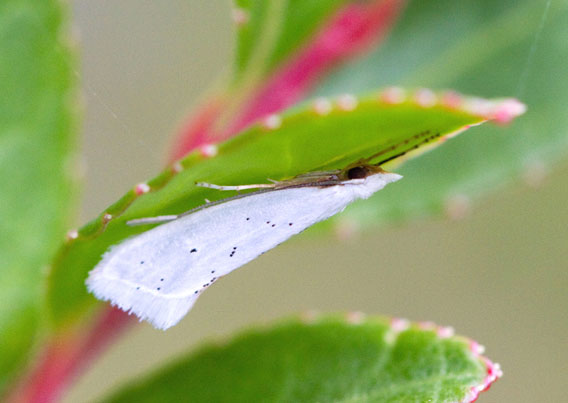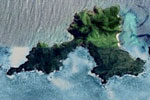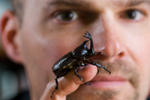
A new species of ermine moth, native to Costa Rica: Eucalantica costaricae. Photo by: Jae-Cheon Sohn and Kenji Nishida.
Researchers have discovered six new species of moth from Central America, according to a new paper in Zoo Keys. The moths belong to the primitive Yponomeutidae family, which are commonly known as ermine moths, since some of the species’ markings resemble the coat of the ermine.
“Yponomeutid moths are important group in tracing the evolution of plant association in Lepidoptera [including both butterflies and moths]. In spite of this importance, the family has been neglected,” said co-author Jae-Cheon Sohn from the University of Maryland, College Park, in a press release.
Five of the six new species are from Costa Rica, while the sixth inhabits Mexico and the southern US. All of the species are in the Eucalantica genus.
“Our discoveries suggest that a high diversity of Eucalantica occurs in the tropical highlands of Central America and the genus is more diverse and widely distributed than previously thought,” Kenji Nishida from Universidad de Costa Rica, San José, said.
According to scientists the majority of life remains unknown. Currently, scientists have described around 1.9 million species on Earth, yet estimates of total species range from 5 to 10 million. More liberal estimates go as high as 100 million. Many tropical insect families remain largely unknown even as tropical forests continue to disappear.
The new species of ermine moth are: Eucalantica costaricae, Eucalantica ehecatlella, Eucalantica icarusella, Eucalantica powelli, Eucalantica pumila, and Eucalantica vaquero (which is present in Mexico and the US).
Caterpillars of these tiny moths often build communal webs. Some of the hundreds of known Yponomeutidae species are considered pests.
CITATION: Sohn J-C, Nishida K (2011) A taxonomic review of Eucalantica Busck (Lepidoptera: Yponomeutidae) with descriptions of six new species. ZooKeys 118: 75. doi: 10.3897/zookeys.118.956
Related articles
Ant surprises on Murciélago Islands in Costa Rica

(06/28/2011) The Murciélago Islands are seven small islands off the northwest coast of Costa Rica in the Area de Conservación Guanacaste (ACG), home to one of the largest intact dry tropical forests in Central America. Despite this, few scientists have studied the biodiversity of these small uninhabited islands. A new study in the open access journal Tropical Conservation Science has attempted to rectify this gap by conducting the first survey of insects, specifically ants, on the islands. Researchers were surprised at the richness of ant species on the island: 50 species were documented, only two of which were invasive species.
Dung beetles: a sewage SWAT team

(06/21/2011) Biology Professor Doug Emlen speaks with Laurel Neme on her ‘The WildLife’ radio show and podcast about the biology and armaments of dung beetles. An expert on the evolution and development of bizarre shapes in insects, Emlen notes that dung beetles are one of the ‘kings’ of odd morphology.
New bee species sports world’s longest tongue
(06/14/2011) A new species of bee discovered in the Colombian rainforest could give the world’s biggest raspberry! Researchers say the new bee has the longest tongue of any known bee, and may even have the world’s longest tongue compared to body size of any animal: twice the length of the bee itself. The new species has been named Euglossa natesi in honor of bee-expert Guiomar Nates.